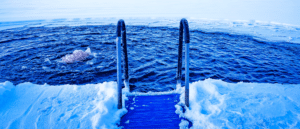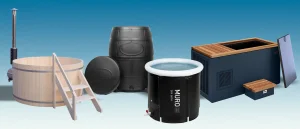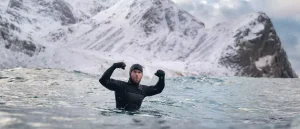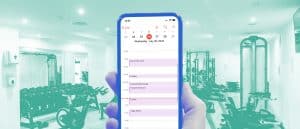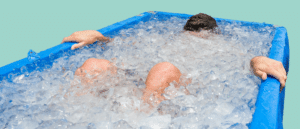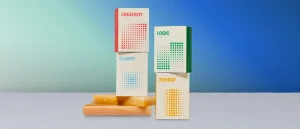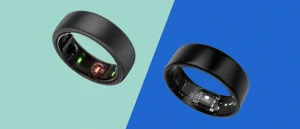The Benefits of Cryotherapy (and What It’s Actually Like to Do It)
- By Will Price
- and Elizabeth Millard
- Fact checked by Joy Ferguson
- August 21, 2023
It was clear to ancient Egyptians some 4,000 years ago and it remains apparent today: From cold plunge tubs to shivering in super-cold air, cryotherapy can have a potent effect on healing the body.
Sometimes referred to as cold therapy, cryotherapy involves the use of freezing or near-freezing temperature as a treatment—and that can encompass ice packs, plunge baths, and enclosed chambers that have been super cooled, according to Carol Mack, DPT, CSCS, a physical therapist and sports performance coach in Cleveland, Ohio.
“Most people use this term (cryotherapy) when talking about ‘whole-body cryotherapy,’ which is a type of cryogenic therapy involving exposure of the entire body to very cold temperatures for a short time,” she says.
This type of cryotherapy is done via cryogenic chamber—a fancy name for a person-sized box that fills the space with nitrogen-cooled air—rather than putting an ice pack on a sore muscle. The freezing temperatures inside the chambers create a thick fog that billows out of the open top, which makes the machines look like something from a sci-fi movie.
Maybe it’s this mental connection that makes cryotherapy seem more, well, fictional, but when longevity experts like Peter Attia and Andrew Huberman (not to mention health-obsessed celebrities like Chris Hemsworth, Kevin Hart, Mark Wahlberg and others) are all in on it, there must be something to it. What are the benefits of cryotherapy? What’s it like to actually be in a cryogenic chamber? Is it really worth the money? I tried it for a month (and read every scrap of relevant research) to find out.
Cryotherapy Benefits
Editor’s note: there are some medical, issue-specific benefits of cryotherapy—cancer treatments, some skin disease therapies, Alzheimer’s prevention, etc.—not listed below. The benefits listed below relate to the recreational addition of cryotherapy into a person’s health routine.
Muscle recovery (and pain relief)
Cryogenic chambers basically work like the bags of frozen peas you put on sore muscles after pushing yourself too hard in a men’s league. Cold temperatures decrease circulation and inflammatory effects (1), which is extremely handy in limiting pain and soreness post-activity. The effect of limiting or reducing pain and soreness is quicker recovery, which means you can work those muscle groups again sooner rather than later.
“People report lower levels of soreness and fatigue when tools like cold water immersion are implemented following strenuous exercise sessions,” says Tom Walters, DPT, author of Rehab Science: How to Overcome Pain and Heal from Injury.
Research on athletes found decreased pain and muscle soreness compared with passive recovery, especially with short icing times under 10 minutes (2).
Mack adds that cryotherapy tends to be best within the first few hours after strenuous training or exercise, since that can prevent soreness or at least lessen its duration and intensity.
(3, 4).
It should be noted that research directed at the possibility that cold therapy might inhibit strength or muscle gains is ongoing, but most research suggests its effects on the two are mostly null.
Lower anxiety
Consistent exposure to the extreme cold of cryotherapy forces the body into a hormonal response, which can have a significant, positive effect on those dealing with anxiety, mood, and depressive disorders (5, 6, 7).
“The suggested method of action needs more research, but cryotherapy has been demonstrated to help with hormone balancing and stimulation of neurotransmitters, the main compounds responsible for mood regulation,” says Tom Ingegno, DACM, doctor of acupuncture and Chinese Medicine in Baltimore.
“One theory is that the intense cold causes the body to kick out endorphins—neurotransmitter pain blockers—which causes all the other neurotransmitters, like serotonin and dopamine, to regulate.”
That said, before buying into the (expensive) world of cryotherapy for those sweet, sweet mental gains, you should absolutely speak to your doctor.
Improved sleep
Though research on whole-body cryotherapy and sleep quality is scant compared to muscle recovery or a number of other medical therapies, a few studies have shown promise. A 2013 study analyzing sleep quality of men’s and women’s basketball players found that sleep quality post-cryotherapy improved, even when sleep duration was reduced (8).
Research in The Journal of Strength and Conditioning Research on middle and long-distance runners revealed that whole-body cryotherapy was particularly useful for improving sleep compared to other options like cold-water immersion (9).
Another study, in the European Journal of Sport Science, noted that three minutes of whole-body cryotherapy after training in the evening improved both subjective and objective sleep quality for participants (10).
“We see this as the number-one reported benefit after pain relief in our clinic,” Ingegno says. “This may be due to the spike in the ‘fight or flight’ response caused by the intense cold. The temporary ‘stress’ from the cryotherapy causes a rebound in the autonomic nervous system, making the patient drop into a state of ‘rest and digest,’ allowing for better sleep.”
Better sleep means better recovery, which means better adherence to training and lesser risk of injury.
Reduced pain and inflammation
“When we look at cryotherapy for pain and injuries, the research shows that the application of cold can help reduce pain, but may actually slow or delay the healing of soft tissue injuries, like muscle strains and ligament sprains,” according to Walters (11).
The recommendations in orthopedics and sports medicine have begun to shift. Instead of recommending cryotherapy after any injury, it’s saved for conditions that mostly involve deeper structures and pain. “For low back pain or arthritis, it is fine to use ice to help reduce pain.”
Boosted metabolism and weight management
As your body ramps up its attempt to stay warm during cold exposure, the effect may affect your metabolism, research suggests.
In a research review published in the Journal of Thermal Biology, eight studies on whole-body cryotherapy were reviewed, and the researchers concluded that the approach may be a promising adjuvant therapy for improving body mass and reducing abdominal obesity, as well as lowering systemic inflammation (12).
Increased strength
Can freezing temps actually improve strength? Research indicates that could be the case. A study in The Journal of Strength and Conditioning Research looking at hand-grip strength found that immediately after exposure to cryotherapy, participants performed better on this type of test compared to a control group that wasn’t exposed to the same below-zero temps (13).
Those researchers concluded that because of this, focused cold therapy should be considered as an option before a training session or sporting event.
Reduced signs of aging
Some studies suggest that cryotherapy may also lead to increased antioxidant levels in the body, according to Saulis Banionis, MD, a board-certified expert in anti-aging medicine in Wellington, Florida.
“Antioxidants help neutralize harmful free radicals, which can damage cells
and contribute to the aging process,” he says. “Also, cryotherapy can trigger the production of cold shock proteins, which are believed to be involved in cell repair.”
Both of these mechanisms may reduce signs of aging: A clinical trial looking at cryotherapy effects on forehead wrinkles found significant improvement with focused cold therapy, leading the researchers to conclude that this may be an effective, non-invasive alternative to wrinkle-reducing treatments (14).
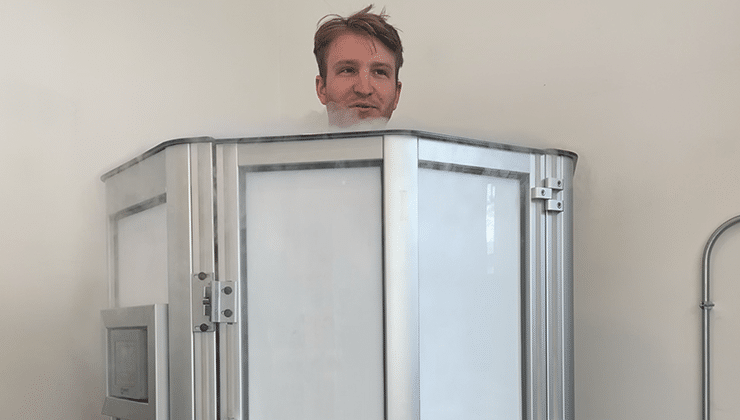
Less intense than cold water immersion
While there isn’t research indicating that cryotherapy is easier than cold plunging (or any other form of cold water immersion), anyone whose done both can tell you plainly that it just is. Cold water immersion is a much sharper, more challenging cold to endure than cryotherapy. Beyond levels of discomfort, cold water immersion also requires you to remain in the water for far longer than the three to five minutes most cryotherapy centers run sessions for. These benefits are corroborated during longevity expert Peter Attia’s deep dive on cold therapy in its many forms.
What Cryotherapy Is Actually Like
How much does cryotherapy cost?
Though putting your body in a cryogenic chamber filled with -100 degree nitrogen-chilled air is its own battle, most people find the cost of cryotherapy to be more intimidating than a few minutes of extreme cold.
Pricing is determined by where you live, as well as the duration of the cryotherapy sessions at your local cryotherapy-equipped facility. Generally, expect to pay between $50 and $100 for cryotherapy sessions, which typically last three minutes on the low end and ten minutes on the high end.
At my cryo center—Bijou Blue in South Burlington, Vermont—three-minute sessions are $55 a piece, but you can buy packages of sessions to get a more favorable rate. This is fairly common at health and wellness centers like this and makes more sense as, depending on your reasons for pursuing cryotherapy, you’ll likely need a number of sessions over a consistent period of time to see results.
Types of cryotherapy
There are many forms of cryotherapy—including the quickly growly world of “cryofacials”—but most people are referring to partial- or full-body cryotherapy when using the term. The only difference between the two, generally, is whether your head is in the chamber or not.
The vast majority of cryotherapy centers use chambers in which your head will be elevated just above the “cold” zone, which, from experience, I can say is a good thing. It becomes extremely difficult to breathe air at the temperature cryo chambers bring it down to. Luckily, there doesn’t seem to be a significant difference in effectiveness between full and partial cryotherapy either—both elicit similar effects, while the more significant factor is how cold the chamber gets, and for how long (15).
What to wear during cryotherapy
Cryotherapy, specifically full-body cryotherapy, is pretty intense. When you arrive for your appointment at your local wellness center or cryo lounge you’ll typically be given a room to dress down—you can do cryo in your underwear or wear some shorts if you want to give yourself a small layer of comfort.
You’ll also be given thick gloves, socks, and booties to wear in the chamber, as your extremities are more sensitive to the extreme cold than the rest of your body. Should you wear your own socks or gloves instead of those provided by your cryo center, it’s also important to make sure that there is no moisture on either, as it will freeze nearly instantly.
How cold is cryotherapy?
Cryotherapy chambers usually produce temperatures between -120 and -300 degrees Fahrenheit, though, anecdotally, most cryotherapy chambers I’ve used in spas and wellness centers bottom out around -200 degrees.
On this note, make sure to tell your cryo tech if it’s your first cryotherapy session—they’ll likely set the machine to a slightly more hospitable temperature level (a cozy -117 degrees was the warmest option at my cryo center), and use a plate to lift your head a few more inches out of the chamber for easier breathing. Everyone’s first experience will feel different, but even the “warmest” setting was challenging initially.
The key to overcoming the cold is mostly mental—your almost-naked body doesn’t really become accustomed to temperatures that deep into the negatives. At those temperatures, maintaining steady, deep breathing goes a long way in relaxing your mind, which is literally going through a fight-or-flight response as it rushes your blood from your arms and legs to the core of your body to keep itself safe.
If you remain under the illusion that it can’t be that cold, I assure you that it can. A sneeze attack hit me as I was walking into my second cryo session, so I did my best to sneeze into my arm like the health-minded person I am. I was wearing a tank top from a gym session earlier in the day, though, and didn’t think twice about covering up a couple sneezes. About 15 seconds into my cryo session and I felt significantly colder than the first time, especially around the inside of my arm and upper chest. Lo and behold, I looked down and a sheet of sneeze frost had formed across that side of my torso.
Despite these deeply cold and uncomfortable temperatures, cryogenic cryotherapy is absolutely more bearable than cold water immersion, which feels like daggers entering every part of my body at once. If you don’t deal with feeling cold well but remain interested in cryotherapy, cryogenic chambers are the way to go.
How often should you do cryotherapy?
There isn’t a clear answer to this question, as it depends on what you’re pursuing cryotherapy for, and the fact that there just isn’t much research on the long-term carryover of cryo treatments.
Is cryotherapy something you should strive to keep in your health routine on a limited cadence over the long run, or something to turn to during periods of more intense exercise or injury recovery?
It’s hard to say. One study on the lasting chemical effects of cryotherapy’s anti-inflammatory qualities found that more is better, at least in terms of sessions needed to “keep” the results over the long run (16). The study was limited to measuring specific anti-inflammatory biomarkers just two weeks after wrapping up cryo sessions, and found that the group of participants who were subject to the most sessions (20, in this study) carried the most signs of long-term benefit.
At the same time, a similar preceding study found lasting effects required at least 10 sessions (17).
The answer to the question of number of sessions, or how often you should go for cryotherapy, is probably more personal than scientific.
If money and convenience aren’t an issue, you could go a few times a week for as long as you want—professional athletes sometimes take multiple cryo sessions in a single day.
If the cost of cryotherapy is a real concern (as is the case for most people), keep cryo in your back pocket during periods of particularly hard exercise, or even as a reward for an exercise milestone.
The Bottom Line
Cryotherapy is an effective way to generally improve your health, but especially your athletic performance. It may also have positive effects on your mood, sleep, and energy levels. Unfortunately, it’s also—by far—the most expensive cold therapy technique. If cost is an issue, consider cold plunging or cold showering as budget alternatives.




